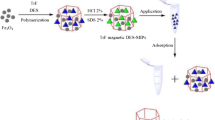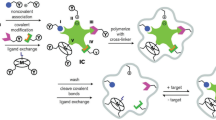Abstract
Unique restricted access media-magnetic molecularly imprinted polymers (RAM–MMIPs) were prepared as magnetic solid-phase extraction (MSPE) material for florfenicol (FF) and are combined with HPLC–UV to extract FF from fetal bovine serum samples. Under the optimization conditions, the resulting materials had a uniform imprinted layer, acceptable adsorption amounts (22.92 mg/g), rapid binding kinetics (80 min) and satisfactory selectivity. In addition, RAM–MMIPs presented satisfactory recoveries (95.6–102.1%), relative standard deviation (RSD) (2.7–3.9%) and lower limits of detection (LOD) (10.5 μg/L). The method was applied to the real samples. Compared with other reported methods, this method exhibits the advantages of simple, fast and, efficient operation, using a relatively small amount of the RAM–MMIPs adsorbent. The developed method can enrich FF from fetal bovine serum samples.
Graphic abstract








Similar content being viewed by others
Data Availability
The data used to support the finding of this study are available from the corresponding author upon request.
Code Availability
Not applicable.
References
Sadeghi S, Olieaei S (2019) Capped cadmium sulfide quantum dots with a new ionic liquid as a fluorescent probe for sensitive detection of florfenicol in meat samples. Spectrochim Acta A 223:117349
Yuan XH, Liu J, Li RL, Zhou JL, Wei JH, Jiao SM, Wang ZA (2020) Chitosan oligosaccharides coupling inhibits bacterial biofilm-related antibiotic resistance against florfenicol. Molecules 25(24):6043
Gaikowski MP, Mushtaq M, Cassidy P, Meinertz JR, Schlies SM, Sweeney D, Endris RG (2010) Depletion of florfenicol amine, marker residue of florfenicol, from the edible fillet of tilapia (oreochromis niloticus x o. niloticus and o. niloticus x o. aureus) following florfenicol administration in feed. Aquaculture 301(1–4):1–6
Barreto F, Ribeiro C, Hoff RB, Costa TD (2016) Determination of chloramphenicol, thiamphenicol, florfenicol and florfenicol amine in poultry, swine, bovine and fish by liquid chromatography-tandem mass spectrometry. J Chromatogr A 1449:48–53
Blondeau JM, Shebelski SD, Hesje CK (2015) Bactericidal effects of various concentrations of enrofloxacin, florfenicol, tilmicosin phosphate, and tulathromycin on clinical isolates of mannheimia haemolytica. Am J Vet Res 76(10):860–868
China PR (2002) Veterinary drug maximum residue limits in the food of animal origin Z. Bull Minist Agric 12:235
Shida SS, Shiono K, Narushima J, Nemoto S, Akiyama H (2019) Determination of total florfenicol residues as florfenicol amine in bovine tissues and eel by liquid chromatography-tandem mass spectrometry using external calibration. J Chromatogr B 1109:37–44
Dudoit A, Mertz C, Chillet M, Chillet M, Cardinault N, Brat P (2020) Antifungal activity of brazilian red propolis extract and isolation of bioactive fractions by thin-layer chromatography-bioautography. Food Chem 327:127060
Lodi G, Pellegrini LA, Aliverti A, Torres BR, Bernardi M, Morbidelli M, Storti G (2017) Recovery of monosaccharides from lignocellulosic hydrolysates by ion exclusion chromatography. J Chromatogr A 1496:25–36
Yu KL, Yue ME, Xu J, Jiang TF (2020) Determination of fluoroquinolones in milk, honey and water samples by salting out-assisted dispersive liquid-liquid microextraction based on deep eutectic solvent combined with MECC. Food Chem 332:127371
Sanchez OA, Sampedro MC, Unceta N, Barrio RJ (2005) Solid-phase microextraction coupled with high performance liquid chromatography using on-line diode-array and electrochemical detection for the determination of fenitrothion and its main metabolites in environmental water samples. J Chromatogr A 1094(1–2):70–76
Sadeghi S, Jahani M (2014) Solid-phase extraction of florfenicol from meat samples by a newly synthesized surface molecularly imprinted sol–gel polymer. Food Anal Method 7(10):2084–2094
Cheng GH, Zhao J, Wang XY, Yang C, Li SY, Lu T, Li X, Wang XF, Zhu GF (2021) A highly sensitive and selective method for the determination of ceftiofur sodium in milk and animal-origin food based on molecularly imprinted solid-phase extraction coupled with HPLC-UV. Food Chem 347:129013
Shakourian M, Yamini Y, Safari M, Safari, (2020) Facile magnetization of metal–organic framework TMU-6 for magnetic solid-phase extraction of organophosphorus pesticides in water and rice samples. Talanta 218:121139
Pichon V, Delaunay N, Combes A (2019) Sample preparation using molecularly imprinted polymers. Anal Chem 92(1):16–33
Fang L, Miao YX, Wei D, Zhang Y, Zhou YC (2021) Efficient removal of norfloxacin in water using magnetic molecularly imprinted polymer. Chemosphere 262:128032
Riskin M, Amram BY, Vered RT, Chegel V, Almong J, Willner I (2011) Molecularly imprinted Au nanoparticles composites on Au surfaces for the surface plasmon resonance detection of pentaerythritol tetranitrate, nitroglycerin, and ethylene glycol dinitrate. Anal Chem 83:3082–3088
Nováková L, Vlčková H (2009) A review of current trends and advances in modern bio-analytical methods: chromatography and sample preparation. Anal Chim Acta 656(1–2):8–35
He J, Song L, Chen S, Li YY, Wei HL, Zhao DX, Zhang GuKR, SS, (2015) Novel restricted access materials combined to molecularly imprinted polymers for selective solid-phase extraction of organophosphorus pesticides from honey. Food Chem 187:331–337
Wu WJ, Su SF, Jiang P, Wang HS, Dong XC, Zhang M (2010) Determination of sulfonamides in bovine milk with column-switching high performance liquid chromatography using surface imprinted silica with hydrophilic external layer as restricted access and selective extraction materical. J Chromatogr A 1217(46):7198–7207
Liu H, Ding J, Zhang K, Ding L (2019) Fabrication of carbon dots@restricted access molecularly imprinted polymers for selective detection of metronidazole in serum. Talanta 209:120508
Chen H, Son S, Zhang F, Yan J, Li Y, Ding H, Ding L (2015) Rapid preparation of molecularly imprinted polymers by microwave-assisted emulsion polymerization for the extraction of florfenicol in milk. J Chromatogr B 983–984:32–38
Wang X, Zhao L, Sun Z (2019) Preparation of ofloxacin-restricted access media–molecularly imprinted polymers for its selective recognition of ofloxacin in milk samples. Chromatographia 82:1041–1050
Ge SG, Yan M, Cheng XL, Zhang CC, Yu JH, Zhao PN, Gao WG (2010) On-line molecular imprinted solid-phase extraction flow-injection fluorescence sensor for determination of florfenicol in animal tissues. J Pharmaceut Biomed 52(4):615–619
Jalilian N, Ebrahimzadeh H, Asgharinezhad AA, Khodayari P (2021) Magnetic molecularly imprinted polymer for the selective dispersive micro solid phase extraction of phenolphthalein in urine samples and herbal slimming capsules prior to HPLC-PDA analysis. Microchem J 160:105712
Zhou YQ, Yang YH, Ma MH, Sun ZA, Wu SS, Gong BL (2018) Preparation of imazethapyr surface molecularly imprinted polymers for its selective recognition of imazethapyr in soil samples. J Anal Methods Chem 2018:1–9
Chen F, Xiao Y, Zhang B, Chang R, Liu D (2019) Magnetically stabilized bed packed with synthesized magnetic silicone loaded with ionic liquid particles for efficient enrichment of flavonoids from tree peony petals. J Chromatogr A 1613:460671
Liang T, Chen LG, Ma Y (2020) Mesoporous structured molecularly imprinted polymer with restricted access function for highly selective extraction of chlorpyrifos from soil. J Chromatogr A 1609:460453
Lv K, He Y, Xiong X, Wang Z, Wang H, Han Y (2015) Layer-by-layer fabrication of restricted access media-molecularly imprinted magnetic microspheres for magnetic dispersion microextraction of bisphenol A from milk samples. New J Chem 39(3):1792–1799
Du B, Qiu T, Chen Z, Cao X, Han S, Shen G, Wang L (2014) A novel restricted access material combined to molecularly imprinted polymers for selective solid-phase extraction and high performance liquid chromatography determination of 2-methoxyestradiol in plasma samples. Talanta 129:465–472
Zhao SW, Sun ZA, Wang XX, Li JM, Zhou YQ, Gong BL (2020) Novel metal-organic framework combining with restricted access molecularly imprinted nanomaterials for solid-phase extraction of gatifloxacin from bovine serum. J Chromatogr B 1157:122338
Vinh NT, Tuan LA, Vinh LK, Quy NV (2020) Synthesis, characterization, and gas sensing properties of Fe3O4/FeOOH nanocomposites for a mass-type gas sensor. Mat Sci Semicon Proc 118:460671
Bin S, Wang A, Guo W, Yu L, Feng P (2020) Micro magnetic field produced by Fe3O4 nanoparticles in bone scaffold for enhancing cellular activity. Polymers-Basel 12(9):2045
Cui Y, Kang WW, Qin L, Ma JH, Liu XG, Yang YZ (2020) Magnetic surface molecularly imprinted polymer for selective adsorption of quinoline from coking wastewater. Chem Eng J 397:125480
Funding
This work was financially supported by the Key Research and Development Program of Ningxia (Special Project for Foreign Cooperation) (No. 2019BFH02004) and the National Natural Science Foundation of China (No. 21565001).
Author information
Authors and Affiliations
Contributions
All authors are contributed equally to this work.
Corresponding author
Ethics declarations
Conflict of interest
The authors declare that there are no conflicts of interest.
Ethical approval
This article does not contain any studies with human participants or animals performed by any of the authors. The fetal bovine serum samples used in this paper was purchased from a commercial institute in China.
Additional information
Publisher's Note
Springer Nature remains neutral with regard to jurisdictional claims in published maps and institutional affiliations.
Supplementary Information
Below is the link to the electronic supplementary material.
Rights and permissions
About this article
Cite this article
Guo, S., Wu, S., Zhao, S. et al. Selective Removal of Florfenicol from Fetal Bovine Serum by Restricted Access Media–Magnetic Molecularly Imprinted Polymers. Chromatographia 84, 845–854 (2021). https://doi.org/10.1007/s10337-021-04074-3
Received:
Revised:
Accepted:
Published:
Issue Date:
DOI: https://doi.org/10.1007/s10337-021-04074-3




